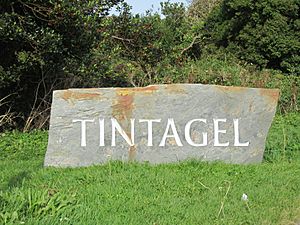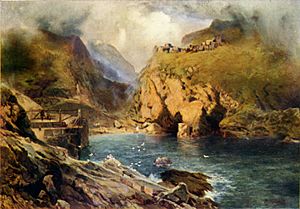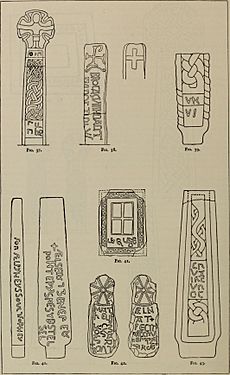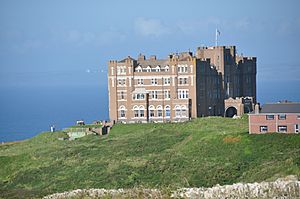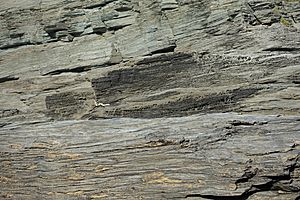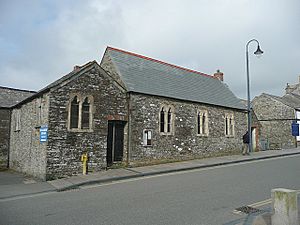Tintagel facts for kids
Quick facts for kids Tintagel
|
|
|---|---|
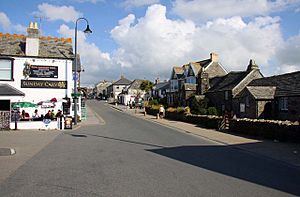 Fore Street, Trevena, in 2009 |
|
| Lua error in Module:Location_map at line 530: Unable to find the specified location map definition: "Module:Location map/data/Cornwall (mainland)" does not exist. | |
| Population | 1,782 (United Kingdom Census 2011 including Bossiney and Knightsmill) |
| OS grid reference | SX057884 |
| Civil parish |
|
| Unitary authority | |
| Ceremonial county | |
| Region | |
| Country | England |
| Sovereign state | United Kingdom |
| Post town | TINTAGEL |
| Postcode district | PL34 |
| Dialling code | 01840 |
| Police | Devon and Cornwall |
| Fire | Cornwall |
| Ambulance | South Western |
| EU Parliament | South West England |
| UK Parliament |
|
Tintagel (pronounced tin-TAJ-el) is a village and parish located on the Atlantic coast of Cornwall, England. It is famous for its connection to the legends of King Arthur and is a popular place for tourists to visit. Many people believe that Tintagel Castle was where King Arthur was born, as written by Geoffrey of Monmouth long ago.
Tintagel has inspired many famous writers. The poet Alfred, Lord Tennyson wrote about it in his poem Idylls of the King. Algernon Charles Swinburne also featured it in Tristram of Lyonesse. Even Thomas Hardy wrote a play called The Famous Tragedy of the Queen of Cornwall at Tintagel in Lyonnesse, which keeps the Arthurian legend alive.
Visitors can explore King Arthur's Great Halls in the village, a large building from the 1930s. A special stone called the Artognou stone was found in 1998, adding to the mystery, even though historians don't think its writing is about King Arthur himself.
Contents
What's in the Name of Tintagel?
The name 'Tintagel' has a bit of a mystery! Experts who study place names, called toponymists, have found it tricky to figure out. It might come from Norman French. If it's from the Cornish language, 'Dun' would mean Fort. One idea is that 'Dun-tagell' means narrow place.
The name 'Tintagol' first appeared around 1136 in a Latin book called Historia Regum Britanniae by Geoffrey of Monmouth. Later, in an early Middle English book, it was spelled 'Tintaieol'.
Interestingly, the village we call Tintagel today was known as Trevena (meaning Village on a Mountain in Cornish) for a long time. The Post Office only started using 'Tintagel' for the village in the mid-1800s. Before that, 'Tintagel' only referred to the headland and the wider parish area.
Tintagel's Area and People
Treknow is the biggest of the other small communities in the Tintagel parish. Other places include Bossiney, Truas, Trebarwith, Tregatta, Trenale, Trethevy, Treven, Trevillet, and Trewarmett. In 2021, about 1,725 people lived in the whole parish. The area of the parish is about 4,281 acres (17.32 square kilometers).
King Arthur and Tintagel's Legends
Tintagel is famous for its strong links to the legends of King Arthur. In Geoffrey of Monmouth's popular book, Historia, it's said that Gorlois, the Duke of Cornwall, kept his wife Igraine safe at Tintagol during a war. Merlin, the wizard, used magic to make Uther Pendragon look like Gorlois. This allowed Uther to enter Tintagel and become the father of King Arthur with Igraine. This story became the main way people explained Arthur's birth in many medieval tales. Parts of the Tristan and Iseult love story are also set in Tintagel.
Exploring Tintagel's Past: Archaeology and Buildings
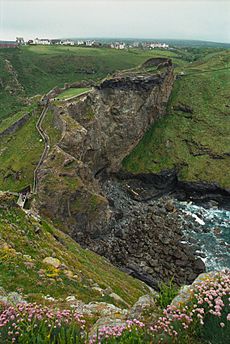
Around the year 700, an old text called the Ravenna Cosmography mentioned a fort or walled settlement called Purocoronavis. Some believe this might have been at Tintagel. If so, it would have been where Tintagel Castle now stands. Digs around the castle show that ships from the Atlantic Coast and the Mediterranean Sea brought goods like wine and oil in the early medieval period. This suggests Tintagel was an important trading spot for a local king or leader.
Digging Up History
Big archaeological digs started in the 1930s at Tintagel Castle. These digs showed that the Tintagel headland was once a very important place in the 5th and 6th centuries. It might have been a high-status Celtic monastery or a princely fortress and trading town. Finding jars from the Mediterranean Sea shows that Sub-Roman Britain was not cut off from the rest of the world. There was a lot of trade in valuable goods with the Mediterranean region.
Items found during these digs are kept at the Royal Cornwall Museum in Truro. In 1998, the Artognou stone was found, adding to Tintagel's Arthurian stories. However, historians don't think the writing on it refers to King Arthur.
Ancient Finds
The largest Bronze Age burial mounds are at Condolden, the highest point in the parish. Others are at Menadue and along the cliffs. In the Iron Age, there were likely forts at Willapark and Barras Head. Two Roman milestones found in Cornwall are at Tintagel. One is in the church and refers to Emperor Licinius (died 324 AD).
Other old items include "King Arthur's Footprint" on the Island. This is a hollow in the rock, partly shaped by people. It might have been used for crowning kings or leaders long ago. The name was probably made up by a castle guide in the 1800s.
There are also two old stone crosses. One, called Aelnat's cross, is beautifully carved. Its inscription says 'Aelnat made this cross for his soul'. Aelnat was a Saxon, one of the few Anglo-Saxons known in the area.
Important Buildings
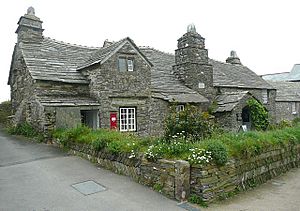
The village has the Tintagel Old Post Office, which dates back to the 1300s. It became a post office in the 1800s and is now owned by the National Trust.
Tintagel Primary School was built in 1914. Older students usually go to Sir James Smith's School in Camelford.
King Arthur's Great Halls in Trevena is a large building from the early 1930s. It was built for a businessman named F. T. Glasscock. He created the "Fellowship of the Knights of the Round Table" to promote Christian values and ideas of medieval chivalry. The building uses different types of Cornish stones. It has 73 stained glass windows showing Arthurian stories and paintings by William Hatherell. Today, it is used as a Masonic Hall.
Hotels in Tintagel
The King Arthur's Castle Hotel (now called Camelot Castle Hotel) opened in 1899. It was meant to be a hotel at the end of a planned railway line that was never built. The hotel has a unique design with towers and battlements, making it look like a castle. Inside, the Great Hall has a replica of the Winchester Round Table.
There were also two hotels on Fore Street, Trevena: the Wharncliffe Hotel and the Tintagel Hotel. The Wharncliffe is now apartments. The Tintagel Hotel, once called Fry's Hotel, was where coaches used to stop before the railway.
Churches and Chapels
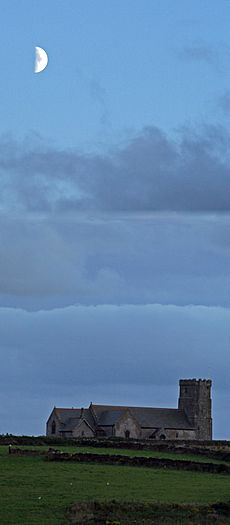
The Church of St Materiana is an Anglican church. It was first built in Norman times, possibly in the late 1000s or early 1100s. It stands on the cliffs between Trevena and Tintagel Castle. The church was restored in 1870. It has modern stained glass windows and a Roman milestone.
There was also a small chapel of St Julitta at the castle, which is now in ruins. In the Middle Ages, another chapel of St Denys was in Trevena.
The Methodist Church has chapels in Trevena and Bossiney. In the past, there were more Methodist chapels in the area.
St Paul's Church, Tintagel has a huge mosaic of the saint. Since 2008, a modern version of Leonardo da Vinci's The Last Supper by local artist Nicholas St John Rosse has been displayed there. It's famous because it shows modern clothing and local people as the apostles. Many people visit this church to see the Miscarriage & Infant Loss Memorial Book, which records the names of babies lost too soon.
Quarrying History
The Tintagel Slate Quarries have shaped the coastline south of Tintagel. People worked these quarries from the 1400s until the early 1900s, mainly for roofing slate. You can still see the remains of old quarry buildings and machinery. The building that is now Tintagel's youth hostel used to be an office and workshop for a quarry. Today, only two slate quarries in Tintagel are still working: Trevillet and Trebarwith Road Rustic Quarry.
Tintagel's Geography and Nature
Beautiful Coastline
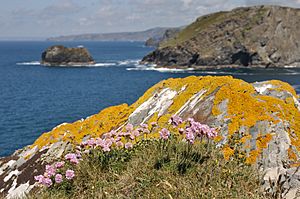
The coastline around Tintagel is special because it's made of old Devonian slate. South of Tintagel, the coast was heavily quarried for this strong roofing material.
The water here often looks turquoise green. This color comes from the slate and sand, which contain small amounts of copper. When the sun is strong, it makes the water glow with this beautiful color.
While very close to the coast, the hill of Condolden is one of the few places in Cornwall outside Bodmin Moor that is over 1,000 feet high. At Trethevy, you can find the waterfall known as St Nectan's Kieve in a wooded valley. The beach at Bossiney Haven is nearby, and Trebarwith Strand, a short walk south, is a lovely beach with clear water and golden sand. There's also a small beach at Tintagel Haven, just north of the castle, and a cave called Merlin's Cave under the castle.
The cliffs from Backways Cove to Willapark are part of the Tintagel Cliffs SSSI (a Site of Special Scientific Interest). This area is protected for its unique coastal plants and interesting geological features.
Tintagel is also part of the Cornwall Area of Outstanding Natural Beauty (AONB). The National Trust owns parts of the cliffs, including Glebe Cliff and Barras Nose. The coastal footpaths, including the South West Coast Path, offer amazing views.
Birds of the Coast
The birds along the coast are fascinating to watch. In 1935, a writer mentioned that Willapark was home to huge groups of seabirds. Inland, you can see crows, including the Cornish chough (a special crow with red legs and beak), and ravens, as well as falcons. The razorbill seabird is also very common at Tintagel.
Plants Around Tintagel
The area around Tintagel is a great place for botanists (people who study plants). You can find many different types of flowers, grasses, and ferns here. It's a rich environment for plant life!
Life and Culture in Tintagel
Tintagel was the location for the Gorsedh Kernow in 1964, a festival celebrating Cornish culture.
Sports and Activities
The Social Hall and the Old School in Fore Street have been important meeting places for many years. Both the Women's Institute and the local football and cricket teams are very popular. Tintagel A.F.C. (football club) has been around for over a hundred years and was even champions of Cornwall in 1955–56. Camelford Rugby Football Club was formed in 2008 and plays its games in Tintagel. Cornish wrestling tournaments have also been held here.
The Tintagel Orpheus Male Voice Choir started in 1926 and has been rehearsing and performing ever since.
Tintagel in Books
Tintagel is a key setting for the Arthurian legends in many poems and plays. Alfred, Lord Tennyson's Idylls of the King and Algernon Charles Swinburne's Tristram of Lyonesse both feature it. Thomas Hardy's play The Famous Tragedy of the Queen of Cornwall at Tintagel in Lyonnesse also uses Tintagel as its setting.
The novelist Dinah Craik visited Tintagel in 1883 and wrote about her trip. William Howitt also wrote about his visit in "A day-dream at Tintagel". Tintagel also appears in a few novels, like Anthony Trollope's short story Malachi's Cove and Charles and Alice Muriel Williamson's novel Set in Silver. In Edith Wharton's unfinished novel, The Buccaneers, the main character meets her future husband, the Duke of Tintagel, while exploring the castle ruins.
Music and Movies in Tintagel
The composer Arnold Bax was inspired to write his symphonic poem Tintagel after visiting the village. Edward Elgar also composed music while in Tintagel.
Some parts of the film Knights of the Round Table were filmed near Tintagel Castle in 1953, with local people acting as extras. The outside of the Camelot Castle Hotel was used in the 1979 film Dracula. The Youth Hostel was used as a coastguard station in the 1981 BBC show The Nightmare Man.
Famous People Connected to Tintagel
The Earls and Dukes of Cornwall, who owned the castle, didn't live in Tintagel, but some did visit. From 1552 to 1832, Tintagel was a parliamentary borough (known as the Borough of Bossiney). Important figures like Sir Francis Drake and Sir Simon Harcourt represented it in Parliament.
Many writers visited Tintagel in the 1800s, including Charles Dickens, Alfred, Lord Tennyson, and Thomas Hardy. John Douglas Cook, the founder of the Saturday Review newspaper, lived in Tintagel sometimes and is buried there.
Henry George White, the village schoolmaster, was also a talented painter. The Very Rev. Cliff Piper, a church leader, was born in Tintagel.
See also
 In Spanish: Tintagel para niños
In Spanish: Tintagel para niños


